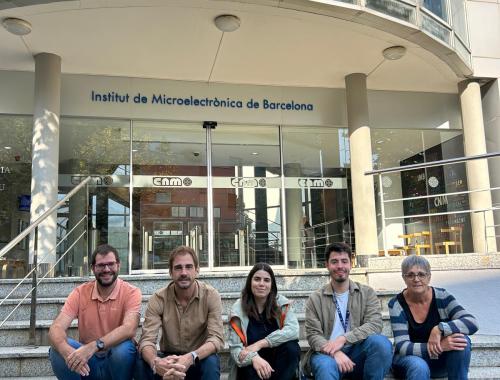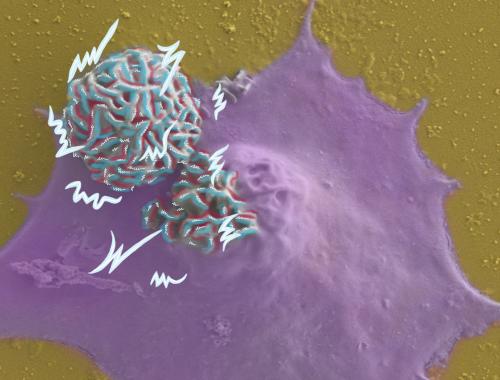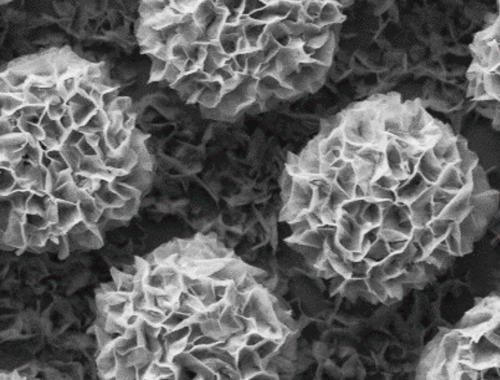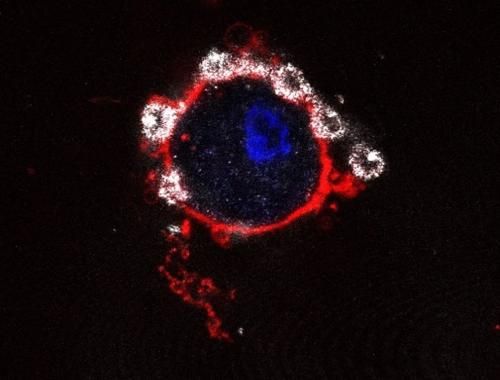The IMB-CNM develops a pioneering microdevice to stimulate cells wirelessly and accurately
A study led by IMB-CNM presents extremely miniaturized piezoelectric microdevices capable of generating electrical signals without the need for wires or batteries, with the aim of stimulating individual cells. This is an advance towards the future of wireless, minimally invasive, and personalized medical therapies
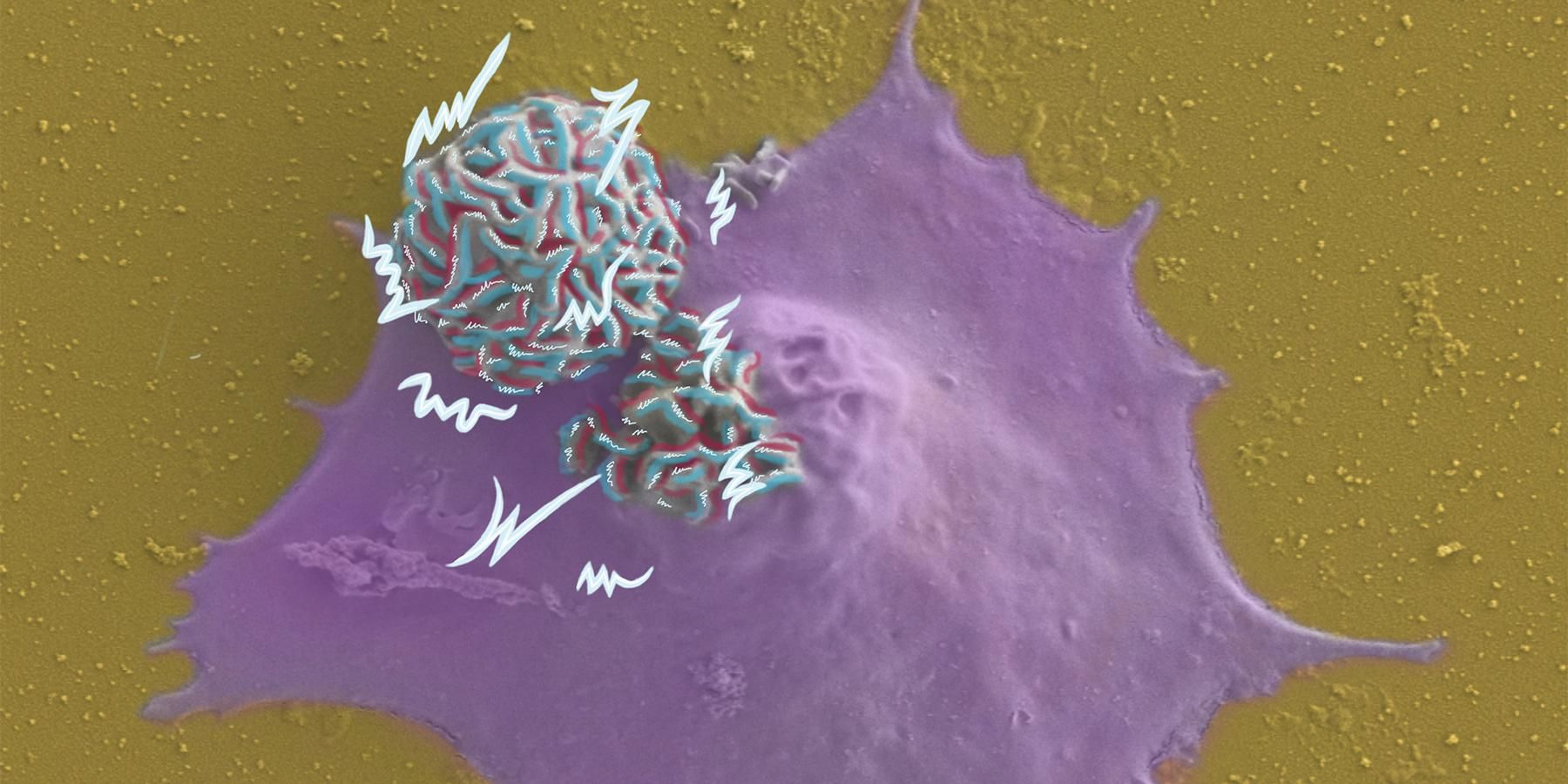
Image taken with a Scanning Electron Microscope (SEM) and colored. The red/blue color represents the local electric field generated by the nanosheets, and the white color represents rays of electricity. The purple color is the cell, which has two microdevices, one inside and one outside. IMB-CNM.
A team from the CSIC's Institute of Microelectronics of Barcelona (IMB-CNM-CSIC) and the Universitat Autònoma de Barcelona (UAB) is designing and developing innovative microdevices based on silicon and zinc oxide microtechnology for the non-invasive, individualized stimulation of cells in the human body. Future applications will focus on wireless electromodulation therapies, with the potential to treat degenerative, neurological, or muscular diseases, regenerate tissue, or facilitate healing.
Therapeutic devices that electrically stimulate the body—known as electroceuticals—represent an alternative for modulating biological functions or treating various diseases. There are established examples, such as pacemakers, but these are millimeter-sized devices that act on large areas of tissue. The current trend is toward micro- and nanodevices capable of stimulating very specific areas of the body and even individual cells. This allows for much more personalized medicine, with fewer side effects and in a less invasive manner.
In this context, piezoelectric materials offer a disruptive approach. Their ability to be miniaturized and generate electricity from mechanical forces—such as deformations or ultrasound—enables the manufacture of devices at the cellular level capable of stimulating these cells in a precise and controlled manner. This opens up the possibility of modulating the activity of excitable cells, such as neurons or muscle fibers, and also of sending signals to non-excitable cells, such as bone cells or osteoblasts, promoting processes of regeneration, proliferation, or migration in them.
The IMB-CNM research proposes a pioneering microdevice in its field, capable of stimulating individual cells with extraordinary resolution and, at the same time, small enough to prevent internalization by the cells themselves. This aspect is key, as it allows for much greater precision in the signal applied or treatment, unlike other approaches based on nanoparticles, where it is not possible to regulate how many particles enter each cell. In this context, the manufacture of the microparticles, carried out entirely in the Micro and Nanofabrication Clean Room at IMB-CNM, has benefited from the institute's extensive previous experience in the field of intracellular microparticles.
The device consists of silicon dioxide microparticles coated with zinc oxide nanolayers, which act as piezoelectric nanogenerators. These microdevices generate electrical signals when they receive mechanical stress from cell adhesion, allowing direct and localized stimulation of the cells in contact.
“The manufacturing process of the microdevice offers great versatility, as it allows both the size of the silicon particles and the dimensions of the nanosheets to be adjusted, facilitating their adaptation to the different stimulation requirements of each cell type,” explains Laura Lefaix, predoctoral researcher at the IMB-CNM and first author of the publication. “By optimizing the nanostructures integrated into the microdevice, we maintain the benefits of nanoscale interactions and enhance its functionality as a nanogenerator when stimulating cells. On the other hand, by adjusting the size of the base microparticle, we facilitate spatial control and interaction with individual cells."
Its design is based on biocompatible materials, such as zinc oxide, and allows for the integration of microelectromechanical systems (MEMS), which are miniature systems that combine electrical and mechanical components on a single platform and can incorporate sensors, actuators, or control circuits. This compatibility opens the door to equipping devices with additional functionalities and a certain degree of “intelligence,” which multiplies their potential in advanced biomedical applications.
In the case of the study, two cell lines of bone cells, healthy osteoblasts, and osteosarcoma cancer cells are used. Different sizes of nanosheets and microparticles are analyzed and how they influence both cellular responses and internalization capacity. In addition, the study reveals that tumor cells internalized up to 50% of the microdevices, compared to less than 10% in the case of healthy cells.
"These microdevices pave the way for wireless therapies at the cellular level, which are much more precise and safer. Unlike nanoparticles, they allow for better control of the stimulus in each cell and, thanks to being based on silicon technology, have enormous potential for advanced biomedical applications," adds Gonzalo Murillo, coordinator of the project in which the study is framed and winner of the 2023 Ángela Ruiz Robles National Research Award for Young People.
The work has been published in the journal Advanced Science under the title Tailoring Piezoelectric Nanogenerators and Microdevices for Cellular Excitation: Impact of Size and Morphology. The research is a collaboration between the IMB-CNM and the UAB. This advance represents an important step towards more precise, less invasive, and safer therapies.
- Andreu Blanquer, Gonzalo Murillo, Laura Lefaix, Marc Navarro and Carme Nogués at IMB-CNM.
- Image taken with a Scanning Electron Microscope (SEM) and colored. The red/blue color represents the local electric field generated by the nanosheets, and the white color represents rays of electricity. The purple color represents the cell, which has two microdevices, one inside and one outside. IMB-CNM.
- Microscope image of the devices manufactured on the wafer. IMB-CNM.
- Nanodevices in contact with the cell. IMB-CNM.





